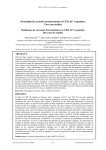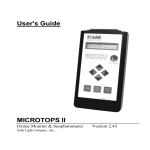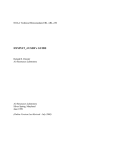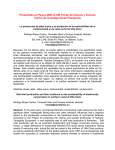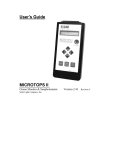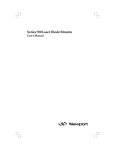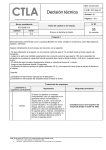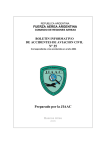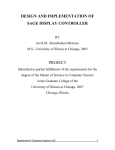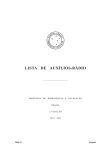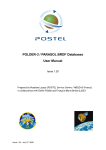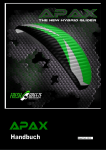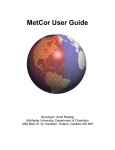Download Stratospheric aerosols measurements at CEILAP, Argentina: Two
Transcript
ÓPTICA PURA Y APLICADA. www.sedoptica.es Stratospheric aerosols measurements at CEILAP, Argentina: Two case studies Mediciones de Aerosoles Estratosféricos en CEILAP, Argentina: Dos casos de estudio René Estevan(1,*), Juan Carlos Antuña(1) and Mario B. Lavorato(2) 1 Camagüey Lidar Station, Meteorlogical Center of Camagüey, INSMET, Carretera Nuevitas Km 7½, PO Box 134, Camagüey 70100 (Cuba) 2 División Radar Laser, CEILAP (CITEFA-CONICET), J.B. de La Salle 4397, B1603ALO Villa Martelli (Argentina) * Email: [email protected] Recibido / Received: 20 – Jul – 2007. Versión revisada / Revised version: 30 – Oct – 2007. Aceptado / Accepted: 10 – Nov – 2007 ABSTRACT: CEILAP lidar, located at Buenos Aires, Argentina (34.6 ºS and 58.5 ºW), was usually employed for atmospheric boundary layer, tropospheric aerosols and cirrus clouds measurements. We conducted two cases study to evaluate the potential of such lidar for lower stratospheric aerosols measurements. Two lidar profiles were processed using the appropriated software, developed at Camagüey Lidar Station. The results show clear evidence of the presence of stratospheric aerosols in the backscattering profiles above the tropopause level. Signal – noise relationship are employed as a quality control and discrimination procedure for determining the capability to retrieve stratospheric aerosols information from such measurements. One comparison between space – time coincident extinction profiles from lidar and SAGE II is conducted. AOD calculated from the lidar derived aerosols extinction profiles were compared with the AOD measured by the AERONET sun-photometer lidar operating at CEILAP. Results corroborate the lidar capabilities for such measurements, as well as the effectiveness of the processing algorithm. We also documented the advantage of using aerological sounding to derive the molecular backscattering profile, instead of using statistical density models, based on mean soundings or the standard atmosphere. The source of the stratospheric aerosols measured by the CEILAP lidar was analyzed using back-trajectories analysis. It allows explaining the agreements and disagreements of the lidar and SAGE II stratospheric aerosols extinction profiles taking into account the sources of the air masses sampled by both instruments. Keywords: Stratospheric Aerosols, Lidar , SAGE II, CEILAP. RESUMEN: El lidar de CEILAP, ubicado en Buenos Aires, Argentina (34.6 ºS and 58.5 ºO), ha sido empleado usualmente para mediciones de capa fronteriza planetaria, aerosoles troposféricos y nubes cirros. Se analizaron dos casos de estudio, para evaluar el potencial de este lidar para mediciones de aerosoles estratosféricos bajos. Se procesaron dos perfiles de lidar empleando el software apropiado, desarrollado en la Estación Lidar de Camagüey. Los resultados muestran una clara evidencia de la presencia de aerosoles estratosféricos en los perfiles de retrodispersión sobre el nivel de la tropopausa. La relación señal – ruido se ha empleado como control de calidad y procedimiento de discriminación para determinar la posibilidad de obtener información de aerosoles estratosféricos de estás mediciones. Se realizó una comparación entre perfiles de extinción coincidentes en tiempo y espacio entre el lidar y SAGE II. El AOD obtenido a partir de los perfiles de extinción por aerosoles fue comparado con mediciones realizadas con el fotómetro solar ubicado en CEILAP perteneciente a AERONET. Los resultados corroboran las posibilidades del lidar para de estas mediciones, así como la efectividad del algoritmo de procesamiento empleado. Se demuestran las ventajas de emplear sondeos aerológicos para obtener los perfiles de retrodispersión molecular, en lugar de emplear modelos de densidad estadísticos, basados en sondeos medios o atmósfera estándar. Se analiza el origen de los aerosoles estratosféricos medidos por el lidar de CEILAP utilizando análisis de retrotrayectorias. Esto permite explicar la similitud o no, de los perfiles de extinción por aerosoles estratosféricos entre el lidar y SAGE II, teniendo en cuenta el origen de las masas de aire muestreadas por ambos instrumentos. Palabras clave: Aerosoles Estratosféricos, Lidar, SAGE II, CEILAP. Opt. Pura Apl. 41 (2) 101-107 (2008) - 101 Pdf downloaded from http://www.thepdfportal.com/estevanopa412008_66101.pdf © Sociedad Española de Óptica ÓPTICA PURA Y APLICADA. www.sedoptica.es. REFERENCES AND LINKS [1] J. C. Antuña, “Efectos Climáticos de las erupciones volcánicas”, pp. 3-19 in Riesgos Climáticos e Impacto Ambiental”, C. García-Legaz, F. Valero, Edts., Editorial Complutense, Madrid (In Spanish) (2003). [2] A. Robock, “Volcanic eruptions and climate”, Rev. Geophys. 38, 191-219 (2000). [3] G. L. Stenchikov, I. Kirchner, A. Robock, H.-F. Graf, J. C. Antuña, R. G. Grainger, A. Lambert, L. Thomason , “Radiative forcing from the 1991 Mount Pinatubo volcanic eruption”, J. Geophys. Res. 103, 13837–13857 (1998). [4] A. Robock, J. Mao, “The volcanic signal in surface temperature observations”, J. Climate 8, 1086-1103 (1995). [5] SPARC, Assessment of Stratospheric Aerosols, L. Thomason, Th. Peter Edts. SPARC Report No. 4 (2006). [6] M. Lavorato, P. Cesarano, E. Quel, P. H. Flamant, “Dual backscatter lidar is operated in Buenos Aires (34.6 °S / 58.5 °W) for determine the atmospheric parameters in cirrus clouds, tropospheric aerosols and ABL”, Proc. 21 International Laser Radar Conference, pp. 75-78 (2002). [7] BSPA, Backscatter Process Application, Manual de Usuario, Certificación de deposito legal facultativo de Obras Protegidas-CENDA, Registro 2366-2004 (2004). [8] R. Estevan, J. C. Antuña, “Updated Camagüey lidar dataset: validation with SAGE II”, Opt. Pura Apl. 39, 85-90 (2006). [9] H. Jäger, T. Deshler, “Lidar backscatter to extinction, mass and area conversions for stratospheric aerosols based on midlatitude balloonborne size distribution measurements”, Geophys. Res. Lett. 29, 1929 (2002). [10] H. Jäger, T. Deshler, Correction to: “Lidar backscatter to extinction, mass and area conversions for stratospheric aerosols based on midlatitude balloonborne size distribution measurements”, Geophys. Res. Lett., 30, 1382 (2003). [11] LARC (2006), http://www-sage2.larc.nasa.gov/data/v6_data/. [12] AERONET, http://aeronet.gsfc.nasa.gov/index.html, [13] R. R. Draxler, G. D. Rolph, “HYSPLIT (HYbrid Single-Particle Lagrangian Integrated Trajectory) Model access via NOAA ARL READY”, Website (http://www.arl.noaa.gov/ready/hysplit4.html). NOAA Air Resources Laboratory, Silver Spring, MD (2003). [14] G. D. Rolph, “Real-time Environmental Applications and Display sYstem (READY)”, Website (http://www.arl.noaa.gov/ready/hysplit4.html). NOAA Air Resources Laboratory, Silver Spring, MD (2003) [15] C. R. Trepte, L. W. Thomason, G. S. Kent, “Banded structure in stratospheric aerosol distribution”, Geophys. Res. Lett. 21, 2397-240 (1994). 1. Introduction As is well know, the stratospheric aerosols play an important role in climate and atmospheric chemistry. Under volcanic perturbed conditions in the stratosphere, several climatic effects have been documented [1,2]. The most relevant effect of the volcanic stratospheric clouds is the influence over the earth radiative balance as has been shown for example after the most intense eruption of twenty century, the Mount Pinatubo eruption in June 12-16, 1991 [3,4]. Both ground and space based measurements of stratospheric aerosols have played a decisive role in providing the information necessary for the studies conducted up to the present. In particular, lidars and the SAGE I and II (Stratospheric Aerosols and Gas Experiment I and II) satellite instruments, provided the biggest spatio-temporal coverage [5]. Together with the important advances in the understanding of the stratospheric aerosols properties, several limitations have been pointed out, mainly associated with the fact that existing aerosol data does not comprise a complete measurement set. Consequently many parameters required for scientific or intercomparison purposes are derived indirectly from the base measurements. Additional difficulties arise from the spatio-temporal gaps in the datasets. In particular few lidar sites have measured stratospheric aerosols in the Southern Hemisphere [5]. The objective of the present paper is to demonstrate that, under certain circumstances, it is possible to recover stratospheric aerosols information from upper tropospheric lidar aerosols measurements. That is particularly possible for measurements conducted in the middle and high latitude, because the altitude of the tropopause decrease from the equator to the poles causing the Opt. Pura Apl. 41 (2) 101-107 (2008) - 102 Pdf downloaded from http://www.thepdfportal.com/estevanopa412008_66101.pdf © Sociedad Española de Óptica ÓPTICA PURA Y APLICADA. www.sedoptica.es stratospheric aerosols layer to be located at lower altitudes. For such a goal we used two upper tropospheric aerosols lidar measurements conducted at the Centro de Investigaciones Láser y sus Aplicaciones (CEILAP), located near Buenos Aires, Argentina [6]. Both measurements are processed and the vertical profiles of stratospheric aerosols backscatter coefficients are derived. The analysis of the signal to noise ratio (SNR) explains the capability of the tropospheric designed measurements for providing information on stratospheric aerosols. Profiles of aerosol backscatter coefficients were converted to aerosol extinction profiles. The comparison of space-coincident SAGE II aerosols extinction profiles with one the lidar derived aerosols extinction profiles demonstrated that the lidar derived profile is representative of the stratospheric aerosols. The comparison of the aerosol optical depth (AOD) derived from lidar and sunphotometer show a good agreement between both instruments. The paper pointed out the possibility of recovering stratospheric aerosols profiles from some original designed tropospheric lidar measurements. 2. Instruments and Dataset The CEILAP lidar (34.6 °S and 58.5 °W), Buenos Aires, Argentina, was designed for measurements of Atmospheric Boundary Layer (ABL), tropospheric aerosols and cirrus clouds. This instrument is located to 18 meters over the sea level. Table I shows principal lidar characteristics [6]. TABLE I Principal characteristics of CEILAP lidar. Parameters Laser, wavelength Energy Frequency Mirrors diameter Field of view Detector Signal processing Magnitude Nd:YAG, 532 nm 300 mJ (max) 10 Hz 50 cm – Newtonian 8 cm – Cassegrain <1.5 mrad Photomultipliers Analogical (photocurrent) For the present study two tropospheric aerosols lidar measurements was employed. One conducted in November 16, 2000 at 02:20:55 LT and the other in June 22, 2001 at 02:04:00 LT. Lidar measurements consist of vertical profiles of returned signals at a resolution of 300m. Measurements processing was conducted using the “BackScatter Process Application” (BSPA) software, developed by the Camagüey Lidar Station team [7,8]. The molecular backscattering was calculated using the nearest, in time, aerological soundings from Buenos Aires. They were November 17, 2000 at 00:00 GMT and June 22, 2001 at the 12:00 GMT. Backscattering aerosol profiles were derived for each day. The SNR was calculated for each one of the two lidar soundings. For making the lidar profiles resolution compatible with the SAGE II aerosol extinction profiles, the backscatter profiles (originally at 300m) were integrated to a resolution of 500 meters, then the resulting backscattering profiles were converted to extinction profiles [8]. For backscatter-toextinction conversion procedure was employed the Jäger coefficients [9,10]. These values have been averaged in the heights range of TP-15, 15-20, 20-25 and 25-30 km for periods of four months. To convert 532 nm extinction profile at 1064 nm wavelength, was used Angstrom exponents from the same author [9,10]. Aerosol extinction profiles from the SAGE II instrument (version 6.20) were downloaded from the LARC (Langley Research Center, NASA) on Internet [11]. Used profiles are from the wavelengths of 525 and 1020nm, with a vertical resolution of 500m. Coincident measurements between SAGE II and the CEILAP lidar were selected using the next spatio-temporal criteria: ±6 degrees in latitude and ±72 hours. In longitude no coincident criteria was established, allowing all the SAGE II measurements inside the predefined latitudinal band. In the case of lidar measurement at November 16, 2000, no coincident measurements were found. However, for June 22, 2001, a total of 6 coincident measurements were found, which appear in Table II. This table contain: the time, location and tropopause (TP) altitude, for each one of the SAGE II coincident profiles. Hourly values of AOD from the CEILAP sunphotometer were downloaded from AERONET website [12] for 500 and 1020 nm respectively. The AOD hourly values belong to November 16, 2000 and June 22, 2001. The AOD data was averaged for each day. The sunphotometer located at CEILAP is a CIMEL CE-138 belonging to AERONET network [12]. TABLE II SAGE II coincident profiles, belonging to June 2001. No. Day 1 24 2 24 3 24 4 24 5 25 6 25 Opt. Pura Apl. 41 (2) 101-107 (2008) - 103 Pdf downloaded from http://www.thepdfportal.com/estevanopa412008_66101.pdf Time 01:39:37 19:17:16 20:53:25 22:29:35 00:00:54 01:45:53 Lat. (S) 40.43 38.44 38.23 38.02 37.87 37.63 Lon. (W) 134.71 37.55 61.37 85.23 109.28 133.08 TP (Km) 9.91 10.32 11.79 12.98 10.83 10.14 © Sociedad Española de Óptica ÓPTICA PURA Y APLICADA. www.sedoptica.es Back-trajectories were calculated using the HYSPLIT (HYbrid Single-Particle Lagrangian Integrated Trajectory) model Version 4.8 [12,13]. For determining the back-trajectories at each one of the SAGE II aerosol extinction profiles location and at the CEILAP lidar site, the model was run backward for 72 hours using reanalysis dataset at the levels of 10, 15 and 20 km for the stratosphere end 2.5, 5 and 7.5 km for the troposphere. 3. Results The vertical profiles of aerosol backscattering coefficients from the CEILAP lidar for both days are shown in Figure 1(a). Tropopause altitudes for each day are denoted with an arrow and the altitude by its side. The profiles resemble clearly the typical structure of tropospheric aerosols in the middle and upper troposphere. Backscattering values are reasonable, with the characteristic of an abrupt increase at the lower levels and a more smooth decay toward the stratosphere. The presence of aerosols well in to the stratosphere above the tropopause is evident showing the possibility for deriving stratospheric aerosols backscatter profiles from some of the measurements originally designed for tropospheric aerosols. Figure 1(b) shows the SNR in logarithmic scale plotted versus altitude. As it is expected, it spans over several ranges of magnitude. An important feature is that yet at around 20 km the signal is ten times the value of the noise. That is the reason why at that altitude the returned signal profile still contains information, in this case about the stratospheric aerosols. This is the criteria that should be applied to evaluate the capability of tropospheric lidar aerosol measurements to provide also, information on stratospheric aerosols. In order to determine the possible sources of aerosols, was employed the backtrajectory analysis for the two lidar measurement days. Figure 2(a) shows the behavior for November 16, 2000, showing that air masses traveled fundamentally over land. This could explain the presence of tropospheric aerosols (Fig. 1(a), 16-11-2000), even below of 5 km, due fundamentally to an important contribution from air pollution over land. Figure 2(b) shows conditions for June 22, 2001, in this case the air masses traveled mainly over maritime regions, with low aerosol content. That is the cause why in the corresponding profile in Fig. 1(a) there are no aerosols below 5 km for this date. Fig. 1. (a) Vertical profiles of the backscatter aerosols coefficient, calculated using aerological soundings. Tropopause altitudes are denoted by the arrows for each profile. (b) Vertical profiles of the SNR in logarithmic scale. Opt. Pura Apl. 41 (2) 101-107 (2008) - 104 Pdf downloaded from http://www.thepdfportal.com/estevanopa412008_66101.pdf © Sociedad Española de Óptica ÓPTICA PURA Y APLICADA. www.sedoptica.es Fig. 2 Backtrajectories in the lower troposphere. (a) November 16, 2000 and (b) June 22, 2001. 4. Sage II and sunphotometer comparisons SAGE II and CEILAP lidar coincident profiles, at 532 nm wavelength, are shown in Fig. 3. In the upper – right corner of each graphic appears the corresponding number listed on Table II. In general we appreciate the good agreement between SAGE II and lidar profiles, mainly for day 24, cases: 2, 3 and 4, in Fig. 3; almost two days after the lidar measurement. The agreement is better in the case 4 than the rest. For the case of the 1064 nm the plots (not shown), reveal similar features, with better agreements for cases 3 and 4. known banded structure of the stratospheric aerosols in non-volcanic conditions [14]. The detailed analysis of the backtrajectories for the other cases (not shown) demonstrated that in general the SAGE II sampled air masses at the level of 10km came from different latitudinal bands that the one sampled at the CEILAP lidar site. Backtrajectories for locations of the SAGE II measurements at altitudes of 10, 15 and 20 km, reveal the variability of the transport at such levels in the region. This variability is in general higher at the level of 10 km in the vicinity of the tropopause, decreasing in direction to the 20 km level. Figure 4 shows the backtrajectories for the case 2 and 4 that appear in Figure 3. In case 4 the Figure 4 shows that the transport was completely zonal. For this case, Fig. 3 shows a good agreement between the lidar and the SAGE II profiles. While for case 2 the Fig. 4 shows that the transport have a noticeable meridional component, most notorious in the upper troposphere around 10 km. Fig. 3 shows for case 2, that precisely in the upper troposphere are the biggest disagreement between SAGE II and lidar profiles. The explanation for such behavior is well Fig. 3 SAGE II and CEILAP lidar coincident profiles, corresponding to June 2001 at 532 nm. Opt. Pura Apl. 41 (2) 101-107 (2008) - 105 Pdf downloaded from http://www.thepdfportal.com/estevanopa412008_66101.pdf © Sociedad Española de Óptica ÓPTICA PURA Y APLICADA. www.sedoptica.es Fig. 4. Backtrajectories in the upper troposphere and lower stratosphere for two SAGE II measurements on June 24, 2001, (a) Case No. 2, and (b) Case No. 4. Table III shows the AOD values at two wavelengths for both, lidar and sunphotometer measurements. Although both instruments measure at slightly different wavelengths, the proximity among the pairs (532 nm and 1064 nm for lidar versus 500 nm and 1020 for the sunphotometer) guarantee no significant differences by this reason. TABLE III AOD measurements both from sunphotometer and lidar for November 16, 2000 and June 22, 2001. Lidar Sunphotometer λ 532nm 1064nm 500nm 1020nm 16/11/2000 4.06¯10-2 2.10¯10-2 6.61¯10-2 3.81¯10-2 22/06/2001 2.85¯10-2 1.48¯10-2 7.63¯10-2 4.85¯10-2 All the AOD values from both instruments are in the same magnitude order, with reasonable values. In all cases, the AOD measured by the sunphotometer show higher values than the one measured by lidar. The reason is associated to the fact that the sunphotometer provides an integrated measurement in the whole column, while the lidar do not measure at the very low level near the surface. Other reason for differences in AOD, between lidar and sunphotometer, are related with that lidar measurements are carry out during night, when atmospheric conditions are very different to the day. The largest differences are 22/06/2001, in this case the lidar signal begin from 5500 m altitude versus 2500 m for day 16/11/2000. In last date, the lidar AOD include information of part of ABL. Lidar AOD for day 16, are greater than day 22, due the polluted continental air masses (figure 2a). However, sunphotometer AOD for day 22 are greater than day 16, this can be associated to the fact, in part, that day 22 sunphotometer measurements initiate to 13:41. 5. Conclusions It has been demonstrated that certain CEILAP lidar tropospheric aerosols measurements, could be processed for deriving stratospheric aerosols profiles. This capability is associated with the good SNR of some measurements at levels above the stratospheric aerosols layer in the lidar location. The resulting lidar profiles of aerosol backscatter coefficients show reasonable values. Comparisons of the lidar derived aerosols extinction profile and AOD with independent instruments show good agreements in general. The comparison conducted with coincident SAGE II aerosol extinction profiles reveals the importance of considering the transport for understanding the degree of agreement of both instruments. It has been shown that the BSPA algorithm and software, designed and implemented for processing Opt. Pura Apl. 41 (2) 101-107 (2008) - 106 Pdf downloaded from http://www.thepdfportal.com/estevanopa412008_66101.pdf © Sociedad Española de Óptica ÓPTICA PURA Y APLICADA. www.sedoptica.es stratospheric aerosols lidar measurements, is suitable to processing tropospheric lidar aerosols measurements. This type of study open the possibility of recovering stratospheric aerosols backscattering profiles from originally designed tropospheric lidar measurements. Branch for providing the SAGE II dataset. This work has been supported by the Cuban National Climate Change Research Program grant 01303177. Acknowledgements Authors thank the NASA Langley Research Center and the NASA Langley Radiation and Aerosols Opt. Pura Apl. 41 (2) 101-107 (2008) - 107 Pdf downloaded from http://www.thepdfportal.com/estevanopa412008_66101.pdf © Sociedad Española de Óptica







